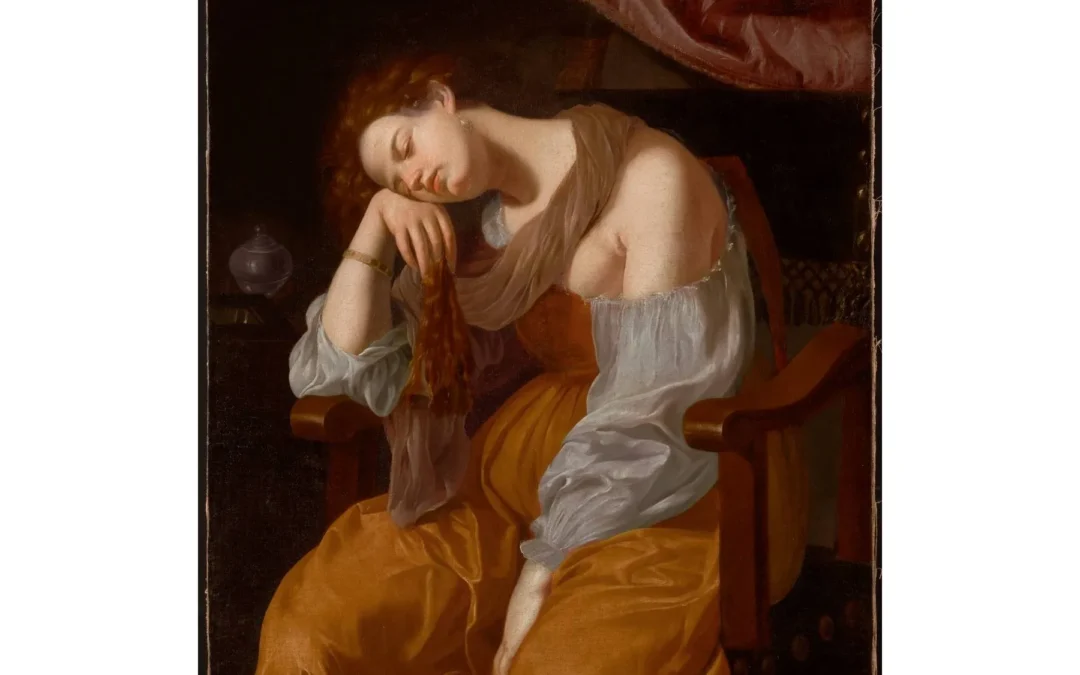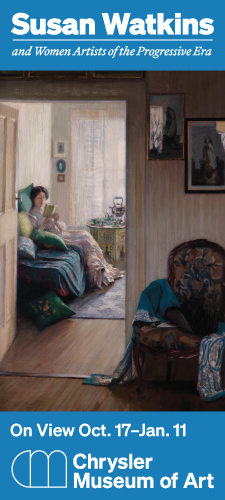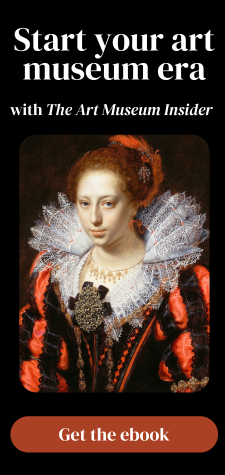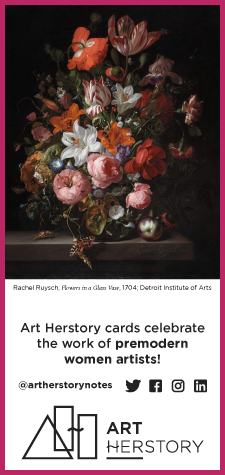Guest post by Olivia Turner, curatorial assistant, Meadows Museum, Dallas
One of the finest art collections in the southeastern United States, the Kimbell Art Museum is committed to expanding its holdings of art by women. Today, we’ll be focusing on the five women artists represented in the Kimbell’s permanent collection—all of whose works are currently on view. Notably, the museum acquired three of these five works within the last five years. These five works span two portraits, two still life paintings, and one abstract sculpture. While there is some overlap in genre, the nuance and diversity within the group speak to the Kimbell’s thoughtful acquisition strategy. Each piece reflects the museum’s careful curatorial approach and highlights a promising trajectory toward more inclusive representation in their collection.

Artemisia Gentileschi (1593–1654), Penitent Mary Magdalene
The first work we’ll look at is the Kimbell’s most recent acquisition. The museum purchased Penitent Mary Magdaleneby Artemisia Gentileschi in 2024. This important addition follows the Kimbell’s 2022 exhibition Slay, which placed one of Artemisia’s Judith Slaying Holofernes in dialogue with Kehinde Wiley’s take on the same subject. This acquisition marks a significant milestone—it is only the eleventh painting by Gentileschi to enter a public US collection, and notably, the first to enter a collection in the southern United States. It is also one of the finest examples of her work currently held in the country.
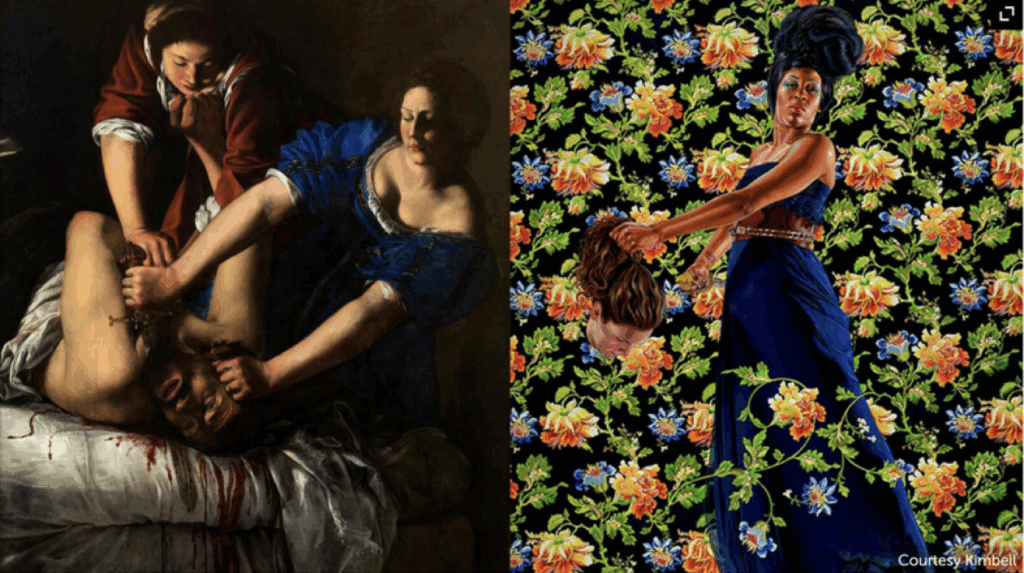
A Trailblazing Artist of Seventeenth-Century Italy
Trained in Rome in her father’s studio, Artemisia Gentileschi was one of the most important and accomplished painters of seventeenth-century Italy. Her father, Orazio Gentileschi, was a devoted follower of Caravaggio, and Artemisia carried on this legacy as the first and perhaps most celebrated Caravaggista. She specialized in history painting—the most prestigious genre in the academic hierarchy—unlike the other women artists represented in the Kimbell’s collection, who worked primarily in portraiture and still life.
While working in Florence, Artemisia further distinguished her style from her father’s by embracing more vibrant color palettes and intensifying the tenebrism that initially aligned her with Caravaggio. Over the course of her career, she also lived and worked in Rome, Venice, and Naples. In 1638, she traveled to London to work for King Charles I alongside her father. She eventually returned to Naples in the early 1640s, where she remained for the rest of her life—though little is known about her later years. In 1616, she became the first woman admitted to Florence’s prestigious Accademia del Disegno. In the second volume of the Illuminating Woman Artists series, Sheila Barker fully explores the life and career of Artemisia Gentileschi.
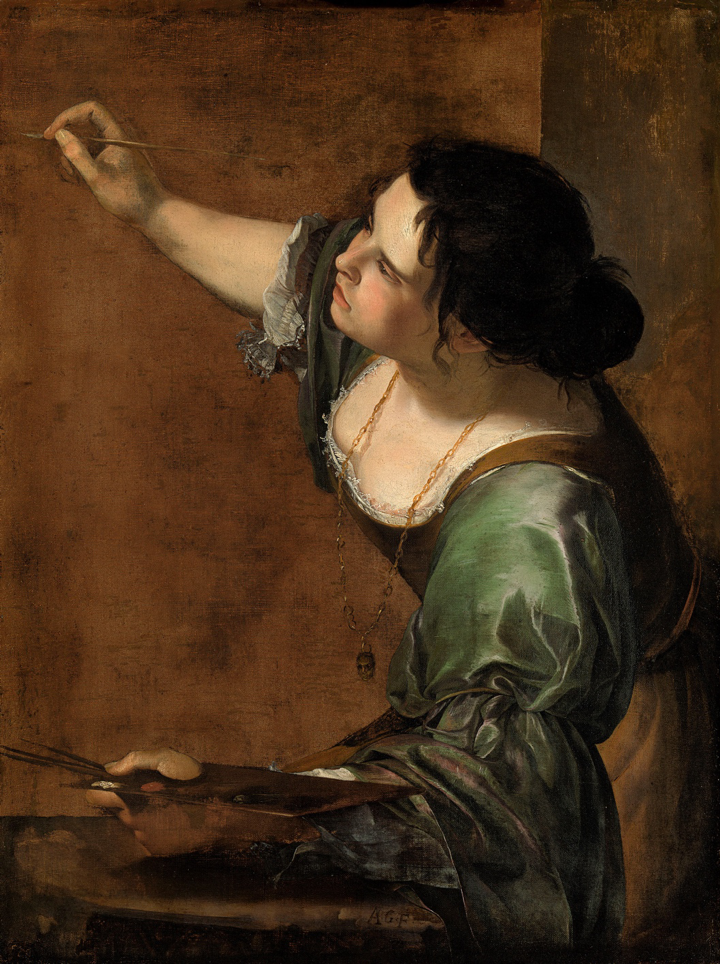
Penitence in Color and Form
Warm tones of amber and sienna ground this portrait of Mary Magdalene. These hues appear in the wooden arms of the chair that supports her, to the crepey folds of her orange dress, the cascading curls of her auburn hair, and the peachy flesh tones of her eyelids, cheeks, and lips. A subtle tear trickling from her eye draws the viewer’s gaze downward through the composition and references the painting’s title, Penitent Mary Magdalene. The figure reflects on her sinful past and renounces her worldly riches to devote herself to Christ. Her glittering tear harmonizes visually with her slightly dangling pearl earring, whose soft luminosity echoes an iridescent pot and brush in the background—two traditional attributes of the Magdalene.
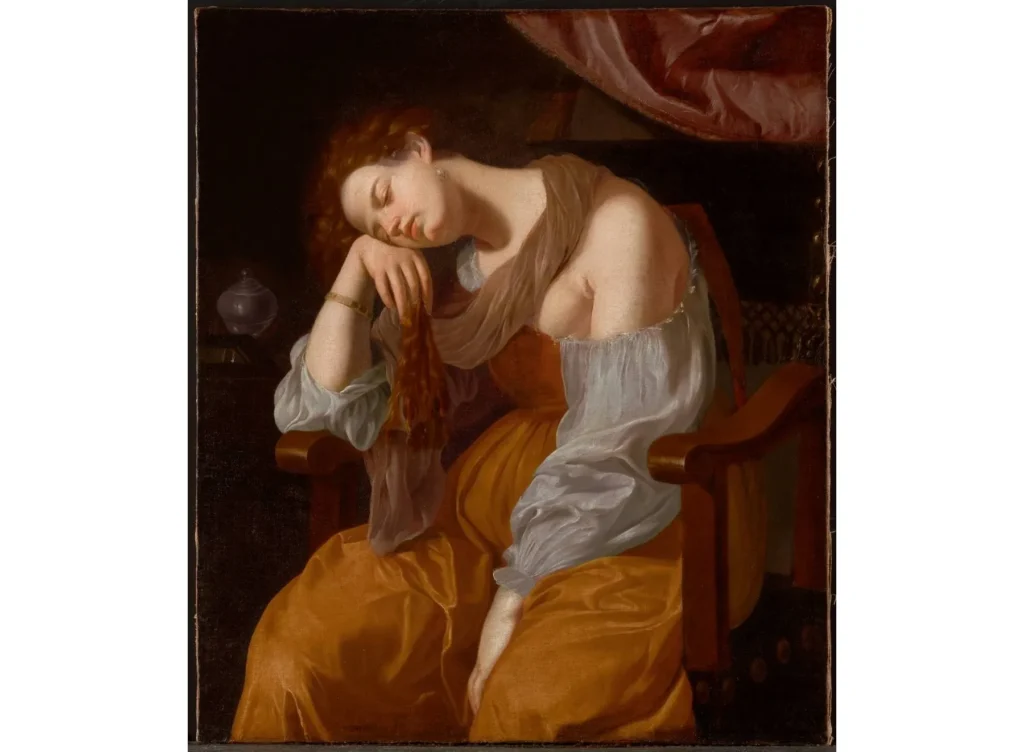
Louise Moillon (c. 1610–1696), Still Life with a Bowl of Strawberries, Basket of Cherries, and Branch of Gooseberries
This still life was the second work by a woman artist in this genre that the Kimbell acquired, following the Vallayer-Coster painting (see below). The museum purchased it in 2022 in honor of the Kimbell’s 50th anniversary. Louise Moillon’s work is held in at least five other US institutions, including the National Museum of Women in the Arts, the Norton Simon Museum, the Art Institute of Chicago, the Grand Rapids Art Museum, and LACMA. The Kimbell’s acquisition in 2022 reflects an ongoing pattern in both their exhibition and acquisition priorities, particularly in increasing representation of women artists.
Earlier this year, Lesley Stevenson published a wonderful article on Moillon in Art Herstory, following the release of her contribution to the Illuminating Women Artists series, co-published by Lund Humphries and Getty Publications. This painting closely resembles one of Moillon’s works at the Norton Simon Museum, completed just a year earlier, which features gooseberries, strawberries, and cherries in a comparable arrangement.
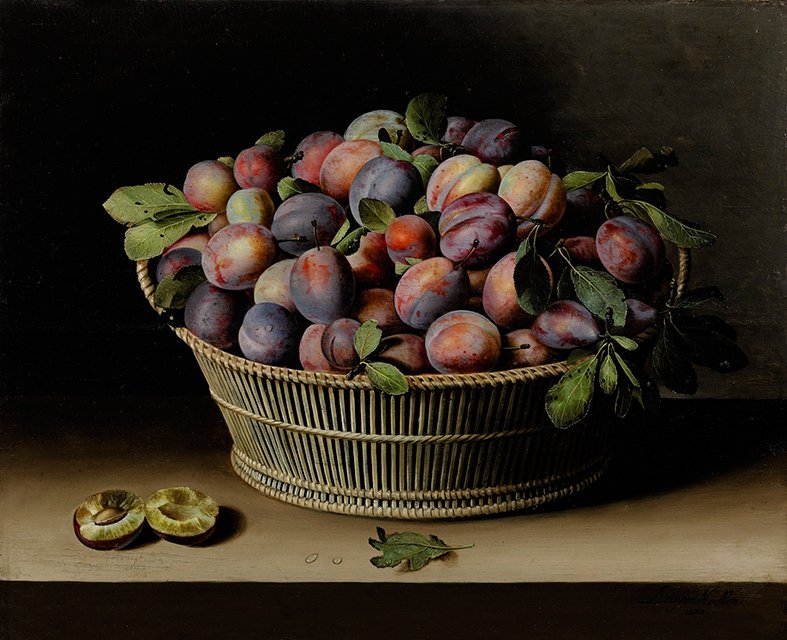
The Making of an Early Master
While Louise Moillon is one of France’s earliest documented women artists, much about her life and work remains a mystery. Even her birth year (1609 or 1610) has been approximated from the inventory of her father’s estate. There is no evidence that Moillon ever left Paris. Because she received her training before the 1648 founding of the Académie Royale—which would later restrict the professional opportunities of many artists, especially women—Moillon was educated in the craft tradition of the family workshop.
Louise’s stepfather, François Garnier, trained her and chose her as his de facto apprentice. A contract drawn up at the time of her mother’s marriage makes clear that Louise was to share the proceeds from the sale of paintings with Garnier. That he chose to collaborate with her rather than her brother Isaac or older sister Marguerite suggests that Moillon demonstrated remarkable precocity as early as age ten and a half.
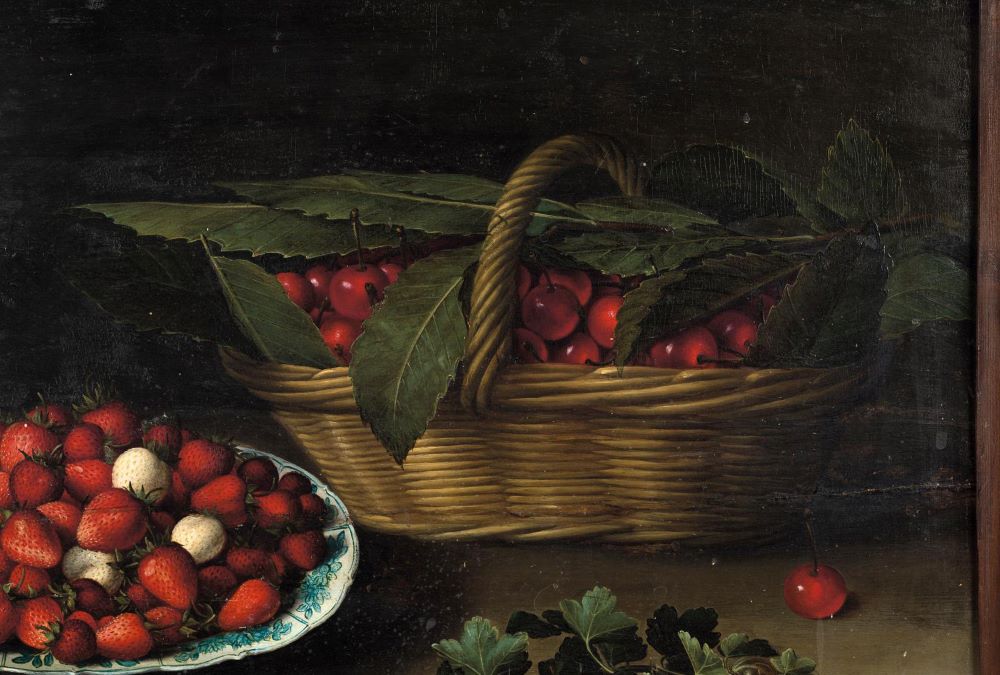
Strawberries, Cherries, and Quiet Power
Although Moillon trained in her stepfather’s still-life tradition—one that leans toward a more horticultural and categorical approach—her own subjects are rendered with greater intimacy and personal regard. The barren table, aside from the artist’s signature and date in the lower right, and the indeterminate background, focus all attention on the titular berries. The otherwise modest blue china bowl and wicker basket quietly showcase Moillon’s technical precision—their intricate details and refined handling feel almost like a warm-up for the main event.
Moillon was best known for her meticulous attention to detail, often expressed through her distinctive treatment of texture and subtle characterization. Prickly green stems crown strawberries dotted with hundreds of tiny seeds, highlighting the individuality of each berry. To the right, a branch of veiny, translucent gooseberries dangles gracefully over the edge of the table. A single glowing cherry follows closely behind, seeming to beckon the viewer toward the basket of its siblings just behind it. These treasures are partially concealed by large, ribbed leaves, each catching just a glint of light. Through this composition, Moillon quietly asserts that she does not require ornate vessels or exotic delicacies to create a captivating image.
Anne Vallayer-Coster (1744–1818), Still Life with Mackerel
This work was the Kimbell’s first acquisition (in 2019) of still life by a woman artist. Vallayer-Coster’s paintings are held in major collections worldwide, including several in the US, such as the Metropolitan Museum of Art, the National Gallery of Art, the National Museum of Women in the Arts, the Frick Collection, the Cleveland Art Museum, and the Dallas Museum of Art. Vallayer-Coster is the subject of an Illuminating Women Artists volume forthcoming in Spring 2026.

Talent, Timing, and Tenacity
Born into a family of artists—her father a miniaturist and goldsmith—Anne Vallayer-Coster was immersed in the arts from an early age. One of her possible teachers, Claude Joseph Vernet, presented her for admission to the Académie Royale when she was just 26 years old. She was unanimously accepted—an extraordinary achievement, considering only three other women were members at the time, all of whom were related to existing male members. In response, the Academy imposed a new rule limiting female membership to just four women at any one time.
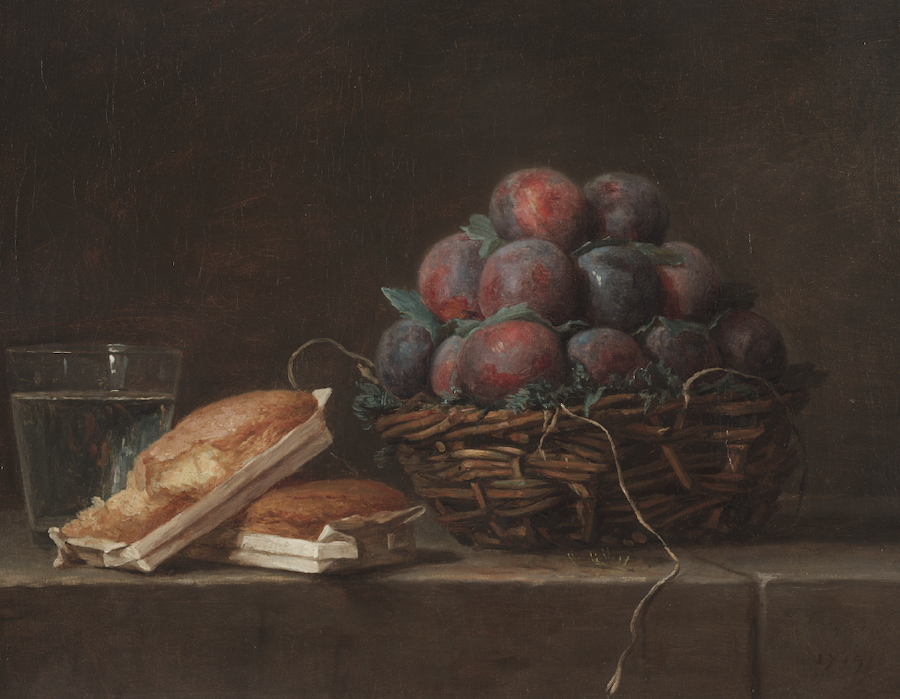
Admission to the Academy was essential for artists seeking critical and commercial success, particularly for women, as it granted access to key patrons, critics, and collectors. Vallayer-Coster exhibited frequently at the Salons, and her early work primarily featured floral still lifes. Queen Marie Antoinette became a patron, and the two developed both a profitable working relationship and a personal friendship. While the French Revolution forced many artists associated with the queen into exile, Vallayer-Coster remained in France. Her focus on still life—seen as politically neutral—may have helped her to continue working. She even went on to paint for the new regime, including Napoleon’s first wife, Empress Joséphine de Beauharnais.
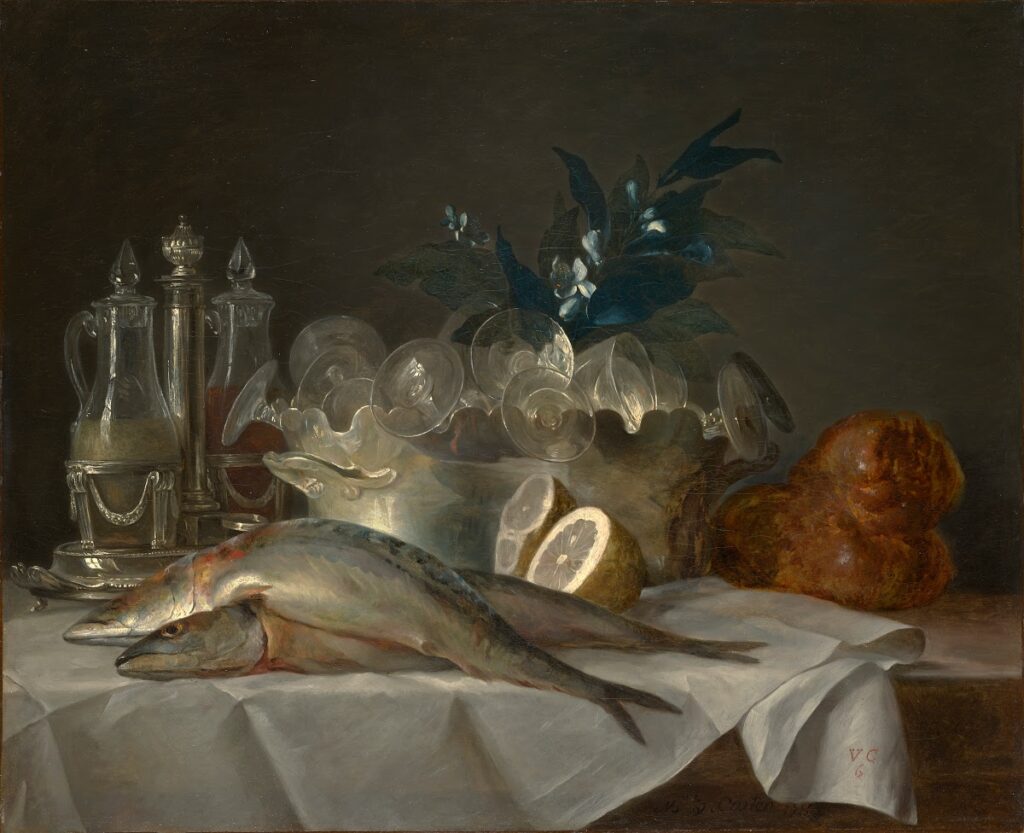
Harmony in Glass, Silver, and Scale
The Kimbell’s Vallayer-Coster work is a beautiful testament to the painter’s mastery of still life. Still Life with Mackerelfeatures classic elements of the genre while also challenging the viewer’s expectations. Two fish, a halved lemon, and an indistinct loaf of bread are posed in the background alongside a modest bouquet of flowers. The artist showcases her impressive skill through the remaining objects, each defined by its reflective qualities. Though composed of different materials—silver, glass, and fish scales—these iridescent surfaces create a harmonious effect throughout the painting. The reflections subtly borrow colors from their surroundings, such as the lemon half’s warped reflection and the warm, buttery tones of the bread. The fish themselves adopt these warm hues, suggesting a final breath of life in their limp bodies.
Vallayer-Coster skillfully pairs elements throughout the composition: the oil and vinegar bottles, the two fish, and the lemon half with its own reflection. This creates a quiet narrative warmth, evoking a sense of camaraderie and companionship within an otherwise lifeless scene. The silver bowl filled with numerous glasses hints at a larger gathering—what are they celebrating? With these thoughtful touches, Vallayer-Coster not only redefines expectations for still life but also asserts her unique skill and signature style.
Barbara Hepworth (1903–1975), Oval Form (Trezion)
This monumental sculpture was acquired by the Kimbell Art Museum in 2011. Hepworth is well represented in other US collections such as the Hirshhorn Museum and Sculpture Garden, SFMOMA, the de Young Museum, the San Diego Museum of Art, and the Columbus Museum of Art.
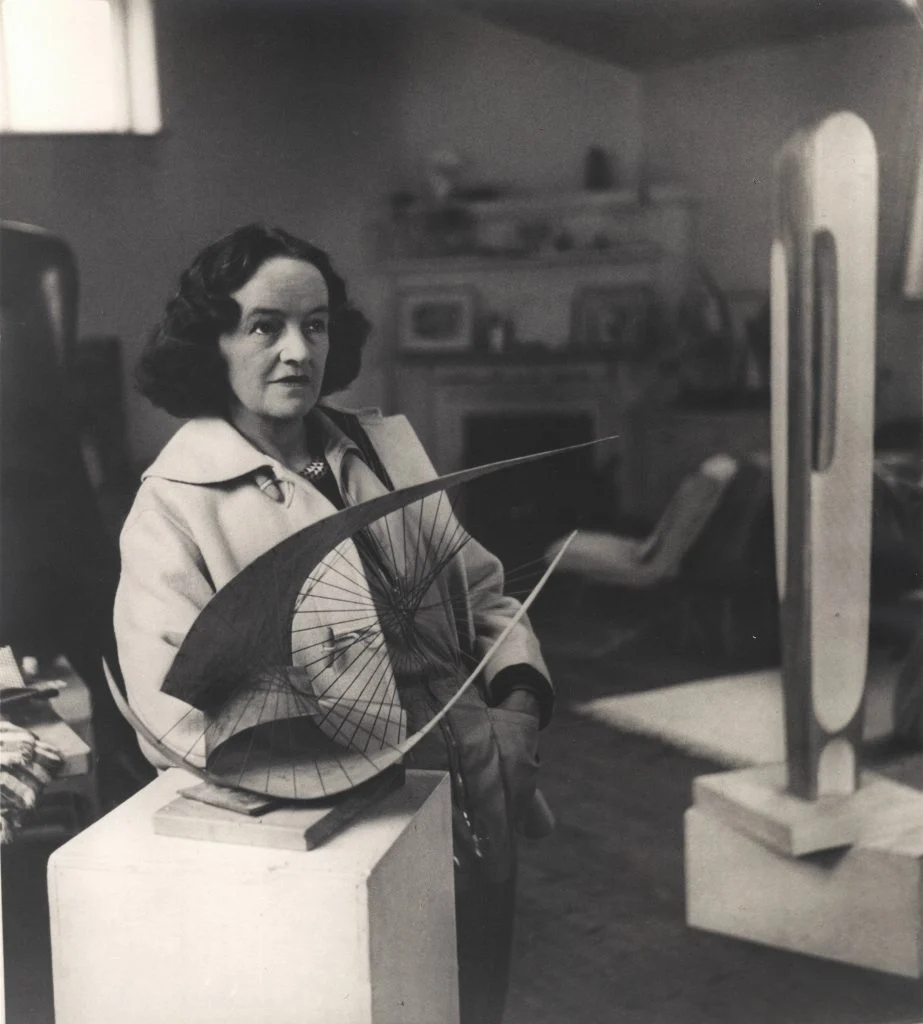
A Pioneer of Modern Sculpture
Barbara Hepworth was a pioneering figure in the development of abstract sculpture in England. At just 15 years old, she committed herself to a life in sculpture. The following year, she enrolled at the Leeds School of Art, where she met fellow future sculptor Henry Moore. Although her style evolved throughout her decades-long career—from early works in wood and stone to a later focus on bronze in the 1950s—she ultimately developed a signature visual language shaped by her deep response to the landscape and her unwavering commitment to abstraction. In 1965, she was appointed Dame Commander of the Order of the British Empire. She died in a fire at her home in St. Ives in 1975.
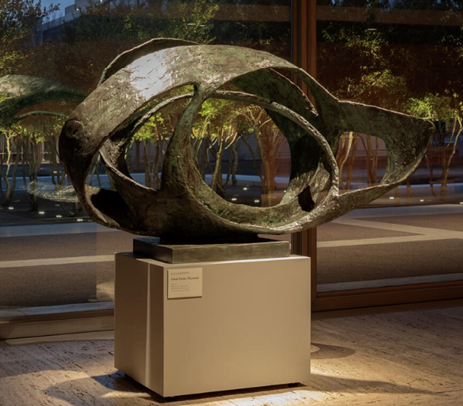
Shaping Home: Trezion
This bronze sculpture, Oval Form (Trezion), exemplifies Barbara Hepworth’s signature style. She likely created it using her preferred method: building shapes with metal armatures to craft the molds from which she would cast her bronzes. The work embodies a contrast central to Hepworth’s practice—creating seemingly airy, weightless forms from heavy materials like bronze. This particular piece evokes the delicacy of curled paper, with ovular shapes repeating and transforming across its surface.
While the sculpture is a clear example of Hepworth’s commitment to abstraction, the subtitle, Trezion, lends the work an intimate, personal layer of meaning. Trezion refers to her home in St. Ives, Cornwall, where she lived and worked from 1939 until her death. This setting deeply influenced her artistic vision, and its naming here transforms the sculpture into a quiet portrait of place and memory. Knowing that it was also the home where she passed away only makes it more poignant.
Elisabeth Louise Vigée Le Brun (1755-1842), Self-portrait
This self-portrait by Élisabeth Louise Vigée Le Brun was the first work by a female artist to enter (in 1949) the Kimbell Art Museum’s collection. Vigée Le Brun is well represented in major US institutions, including the Saint Louis Art Museum, the Nelson-Atkins Museum of Art, the Metropolitan Museum of Art, the Getty Center, and the Legion of Honor, among others.
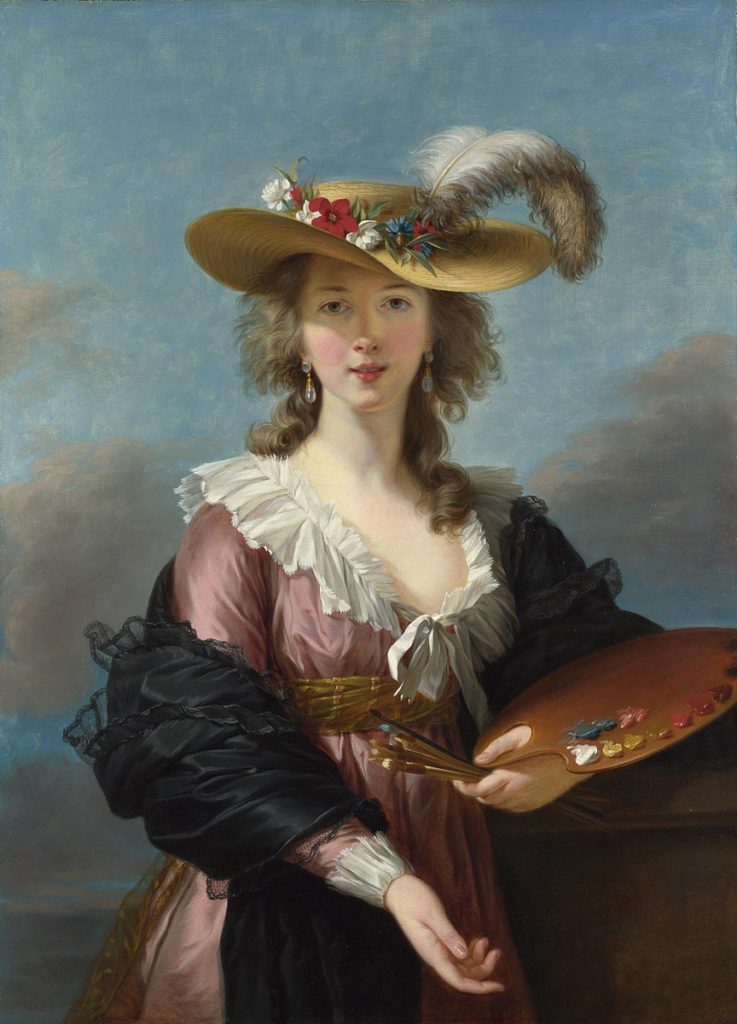
Luminous Portraits and a Life Abroad
Elizabeth Vigée Le Brun enjoyed significant critical and commercial success during her lifetime. In 1776, she married the art dealer Jean-Baptiste-Pierre Le Brun, and just three years later, the court summoned her to Versailles to paint Queen Marie Antoinette. This was the first of over twenty portraits she would create of the queen throughout their close friendship. This royal relationship ultimately secured her acceptance into the Royal Academy in 1783, despite initial resistance due to her ties to the art trade through her husband. In addition to her royal commissions, Vigée Le Brun painted numerous self-portraits, often styled in homage to artists she admired. This work, along with her Self-Portrait in a Straw Hat, reflects her admiration for Rubens, especially in her rendering of luminous flesh tones and iridescent accents.
With the outbreak of the French Revolution in 1789, she left France and spent the next twelve years traveling through Rome, Naples, Vienna, Berlin, St. Petersburg, and Moscow. During this period abroad, she further established herself as a celebrated portraitist and a prominent figure in European society. Her memoirs, Memoirs of Madame Vigée Le Brun(1835–37), provide a vivid account of her life and offer a rare, intimate glimpse into the world of an eighteenth-century woman artist. Over the course of her career, she claimed to have produced around 900 works—600 portraits and about 200 landscapes.
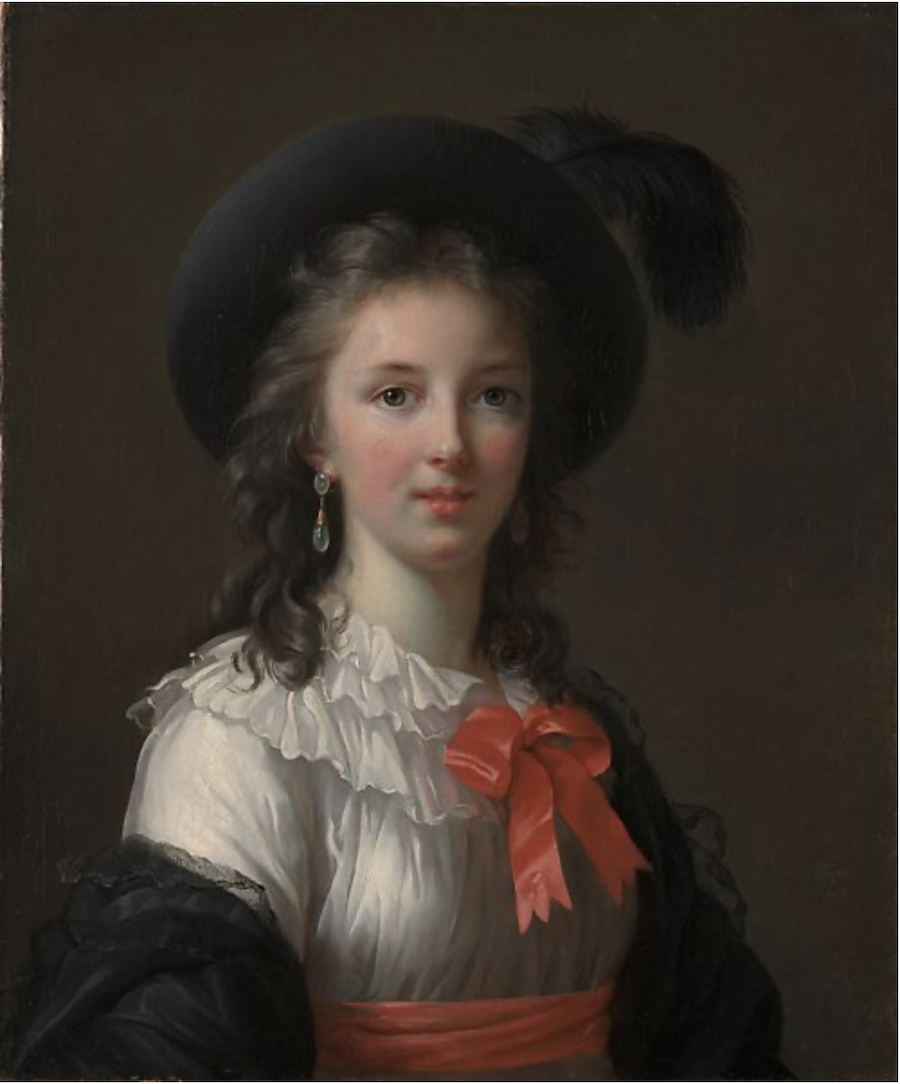
A Self-Portrait of Poise and Skill
While Vigée Le Brun’s famous Self-Portrait in a Straw Hat at the National Gallery in London references her profession through the inclusion of an artist’s palette, the Kimbell’s portrait presents her instead as a youthful and distinguished woman of high society—a genre she mastered through her prolific commissions from Europe’s elite. Though seemingly simple in composition, the portrait demonstrates her remarkable skill in rendering a variety of textures and materials. These include the shimmer of a satin bow, the soft folds of a crepey tunic, the delicacy of black lace, and the airy flourish of a feather. With this technical virtuosity, the painting not only introduces us to Vigée Le Brun the artist, but also to Vigée Le Brun the woman.
Conclusion
Given that the Kimbell has acquired three of these works within the past decade, it’s reasonable to expect that more works by women artists will join the museum’s collection in the years ahead. This thoughtful acquisition strategy reflects the museum’s commitment to building a comprehensive, encyclopedic collection. Though these five works are powerful and commanding in their own right, they are part of a broader context—the Kimbell’s world-class holdings. The museum boasts one of the finest collections in the southern United States and is an essential stop for anyone in the area. I look forward to seeing which women artists the Kimbell will welcome into the collection next.
Olivia Turner is the curatorial assistant at the Meadows Museum in Dallas, Texas, and a museum education intern at the Nasher Sculpture Center. She holds a Master’s degree in Art History from the University of Alabama, where her thesis examined the circumstances of women artists in early modern Seville, focusing on the daughters of Seville’s workshops and the career of Luisa Roldán. Olivia’s research interests center on women artists of the early modern period, particularly their roles within religious and cultural contexts. During her time in Dallas, she also completed a graduate certificate in Art Museum Education from the University of North Texas, enhancing her skills in both curatorial practice and museum education. This fall, Olivia will begin her PhD in art history as a Legacy Fellow at Florida State University.
Art Herstory blog posts by the same author:
Frida: Beyond the Myth at the Dallas Museum of Art, by Olivia Turner
Luisa Roldán: Escultora Real at the Museo Nacional de Escultura, by Olivia Turner
Other Art Herstory blog posts you may enjoy:
Museum Exhibitions about Historic Women Artists: 2025
Roma Pittrice: Women Artists at Work in Rome Between the Sixteenth and Nineteenth Centuries, by Alessandra Masu
Seductive Surfaces: Anne Vallayer-Coster’s Vase of Flowers and Conch Shell at the Met, by Kelsey Brosnan
Louise Moillon: A pioneering painter of still life, by Lesley Stevenson
Early Modern European Women Artists at the Montreal Museum of Fine Arts, by Erika Gaffney
Exhibiting Artemisia Gentileschi; From the Connoisseur’s Collection to the Global Museum Blockbuster, by Christopher R. Marshall
Artemisia Gentileschi: What Wasn’t in the London Exhibition and Why it Matters, by Jesse Locker
Two of a Kind: Giovanna Garzoni and Artemisia Gentileschi, Guest post by Mary D. Garrard
The Priceless Legacy of Artemisia Gentileschi: A Curator’s Perspective, by Judith W. Mann

